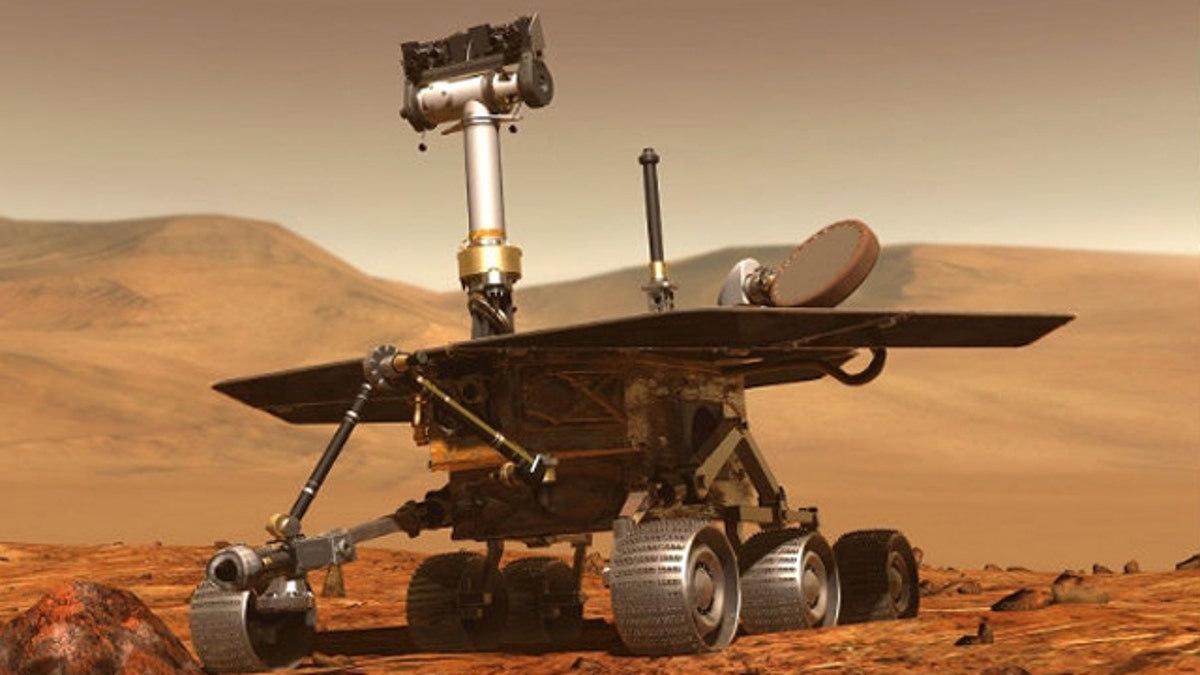
The solar-powered rover Spirit lasted years longer than expected, dazzling scientists and the public along the way. (NASA)
The roving days are over for NASA's Mars rover Spirit after more than six years rolling across the Martian surface, the space agency announced Tuesday.
NASA engineers have decided to abandon efforts to rescue the Spirit rover from the deep Martian sand that snared it in May 2009. Instead, they are trying to prepare the rover to survive the harsh winter ahead in Mars' southern hemisphere. If the rover survives, it will serve as a fixed science outpost, mission managers said.
SLIDESHOW: Mars Rover Spirit's Best Photos
"This is not a day to mourn Spirit. This is not a day of loss," said Doug McCuistion, director of NASA's Mars exploration program, in a teleconference. "Its driving days are likely over, however its contribution will continue."
Spirit is stuck up to its wheel tops in Martian sand and slightly tilted back in a spot on Mars that scientists have named "Troy." The rover got stuck on May 6, when its wheels broke through a hard crust covering the soft sand and sunk into the sand trap.
"Spirit has encountered a golfer's worse nightmare," McCuistion said.
Engineers at NASA's Jet Propulsion Laboratory (JPL) in Pasadena, Calif., spent months working on ways to extract Spirit from its sandy predicament. Those efforts - which began in November - have been unsuccessful. Making matters worse, two of the rover's six wheels are broken, hampering its escape attempts.
Spirit and its robotic twin Opportunity have been exploring different parts of Mars since they landed in January 2004. Since then, the long-lived rovers have far outlasted their initial 90-day mission plans and discovered new insights into the history of water on Mars. Opportunity is currently working fine and is studying an odd rock called "Marquette Island" – which appears to have been ejected from deep inside Mars during an impact – as it heads toward a giant crater called Endeavour.
McCuistion called the Spirit's situation "inextractable." He didn't rule out that Spirit could free itself by accident, but that's not the goal anymore.
"Right now, our plan is to worry about getting through the winter," McCuistion said.
Recent attempts to drive Spirit backwards have made some improvement to its tilt toward the sun, which is vital for the rover's solar arrays to generate the power to stay alive.
During winters on Mars, the sun is low in the sky, so engineers try to perch Spirit and Opportunity on north-facing slopes to maximize the amount of sunlight their top-mounted solar panels can collect. NASA is hopeful that Spirit can be wiggled into a favorable position before the full brunt of winter arrives in a few months.
If successful, Spirit could continue to operate through the Martian winter, or possibly enter a hibernation-like mode until the season passes and springtime returns, bringing with it more favorable levels of sunlight.
"We have hope that Spirit will survive this cold, dark winter that we have ahead of us and be ready to do more science come springtime," said the rover mission's principal investigator Steven Squyres of Cornell University in Ithaca, New York.
Squyres said Spirit can still study the Mars dirt around Troy. There is also a tantalizing chance for scientists to determine if the core of Mars is liquid or solid iron. They could do that by using Spirit's radio signals to record the motion of Mars and deduce if the red planet's core is molten or not, he added.
"Totally new science," Squyres said.
But first, Spirit must survive the next winter on Mars.
Rover project manager John Callas of JPL said that, in the end, it will all come down to power. If Spirit does not find a good sunward tilt for the coming winter, it could experience a so-called "low-power fault" and shut down all non-essential systems.
"The rover will be like a polar bear, hibernating," Callas said. "It could be for many months...on the order of six months, that the rover will be in this state."
Unlike NASA's long-silent Phoenix lander in the Martian arctic, Spirit is designed to hibernate through winters on Mars and will experience temperatures of minus 45 degrees Celsius, Callas said. But Spirit is not a new rover, so its systems could be susceptible to damage due to age, he added.
"There's no guarantee that the rover will be able to survive these colder temperatures," Callas said.
It will likely be frustrating for NASA engineers as they await word from Spirit to determine if the rover survives the coming winter. After all, NASA has spent $900 million on the Mars rover mission, and typically spends $20 million a year to support Spirit and Opportunity during their extended treks on the red planet.
"That'll be challenging for the team, but it's just something we'll have to be disciplined about," Callas said.
Copyright © 2010 Space.com. All Rights Reserved. This material may not be published, broadcast, rewritten or redistributed.
